Fast Food
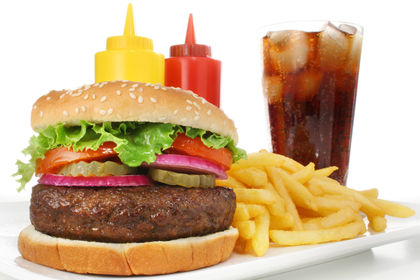
BUSINESS PLAN
PASTA EXPRESS
1018 Southwestern Highway
Farmington Hills, MI 48151
This business plan for a fast food pasta restaurant describes how the owners have built and plan to continue building their worldwide fast food pasta franchise. The owners explain in the plan how the fast food pasta industry is a newly developing industry. By taking advantage of this opportunity now, while the concept is new and hot, the owners plan to continue expanding their pasta empire.
- EXECUTIVE SUMMARY
- PROJECT DESCRIPTION AND FINANCIALS
- COMPANY DESCRIPTION
- INDUSTRY ANALYSIS
- COMPETITIVE ANALYSIS
- HISTORY
- CURRENT STATUS
- MANAGEMENT PROFILE
- ADVISORY BOARD
- COMPILED FINANCIAL STATEMENTS
EXECUTIVE SUMMARY
Pasta Express specializes in quick serve pasta. The originator of the fast-food pasta concept, it began franchising in 1992, and has grown from one company-owned location to 62 franchises.
The fast-food pasta concept allows the customer to enjoy a high-quality, great tasting meal within minutes of placing the order. A typical consumer is a middle- to upper middle-income adult, age 25 to 55 who is tired of fried fast food and has chosen to eat a nutritious pasta meal instead.
Pasta Express has grown substantially in the past two years. In 1995, Pasta Express sold the rights for twenty franchise units in the state of Wisconsin and for thirty units in the Corpus Christ-Houston, Texas area. Several other franchises in Missouri, Florida, California, and Colorado are in various stages of the sales process.
Pasta Express has experienced a 500% increase in franchise leads over the past two years for the following reasons:
Immediate Profitability: Because of our expertise in site selection, the effective Grand Opening, and ongoing advertising, franchisees can often become profitable in the first month of operation.
Mass Appeal: The large and diverse menu gives Pasta Express the strength and flexibility to appeal to every kind of consumer. The Italian food lover, the health conscious eater, the pizza lover, the salad eater, children and adults, and families or couples can all find items to enjoy on the menu.
Ease of Replication: A good chef can help increase sales, and a good business operator can help up to six restaurants perform well, but only a food concept that can be easily replicated can become a national and international sensation. Ease of operation is what separates Pasta Express from other dynamic food concepts. One does not need any experience in the food industry to make the system work successfully. All that matters is that one follow the franchise program.
With so many advantages, the only downside is lack of capital. With or without financing, Pasta Express will continue to grow. The question is whether it can grow quickly enough to seize the opening available in the marketplace. With additional financing, Pasta Express can easily become the next dominant trend in the quick serve food market.
PROJECT DESCRIPTION
Pasta Express is currently looking for investment capital of $250,000. This investment will be taken in two installments—one installment of $175,000 to be paid immediately, and another $75,000 to be paid in six months.
Use of Investment Capital

| Phase I—Investment Capital | Investment | Expense |
| 175,000 | ||
| Expenditures | ||
| Marketing | 75,000 | |
| Working Capital | 75,000 | |
| Systems Upgrade | 25,000 |
| Phase 2—Investment Capital | 75,000 | |
| Marketing Expense | 75,000 | |
| Totals | 250,000 | 250,000 |
Due to expansion, we are in need of additional operations employees, marketing, and office support. Funds in this category will be used to add and upgrade computer hardware and software, phone systems, and to purchase a booth for franchise shows.
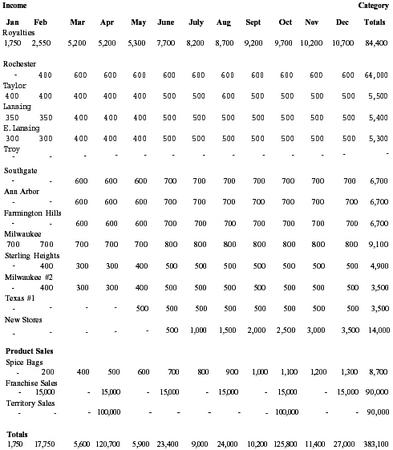
| 1996 Projected income | |||||||||||||
| Income | Category | ||||||||||||
| Jan | Feb | Mar | Apr | May | June | July | Aug | Sept | Oct | Nov | Dec | Totals | |
| Royalties | 1,750 | 2,550 | 5,200 | 5,200 | 5,300 | 7,700 | 8,200 | 8,700 | 9,200 | 9,700 | 10,200 | 10,700 | 84,400 |
| Rochester | – | 400 | 600 | 600 | 600 | 600 | 600 | 600 | 600 | 600 | 600 | 600 | 64,000 |
| Taylor | 400 | 400 | 400 | 400 | 400 | 500 | 500 | 600 | 500 | 500 | 500 | 500 | 5,500 |
| Lansing | 350 | 350 | 400 | 400 | 400 | 500 | 500 | 500 | 500 | 500 | 500 | 500 | 5,400 |
| E. Lansing | 300 | 300 | 400 | 400 | 400 | 500 | 500 | 500 | 500 | 500 | 500 | 500 | 5,300 |
| Troy | – | – | – | – | – | – | – | – | – | – | – | – | – |
| Southgate | – | – | 600 | 600 | 600 | 700 | 700 | 700 | 700 | 700 | 700 | 700 | 6,700 |
| Ann Arbor | – | – | 600 | 600 | 600 | 700 | 700 | 700 | 700 | 700 | 700 | 700 | 6,700 |
| Farmington Hills | – | – | 600 | 600 | 600 | 700 | 700 | 700 | 700 | 700 | 700 | 700 | 6,700 |
| Milwaukee | 700 | 700 | 700 | 700 | 700 | 800 | 800 | 800 | 800 | 800 | 800 | 800 | 9,100 |
| Sterling Heights | – | 400 | 300 | 300 | 400 | 500 | 500 | 500 | 500 | 500 | 500 | 500 | 4,900 |
| Milwaukee #2 | – | 400 | 300 | 300 | 400 | 500 | 500 | 500 | 500 | 500 | 500 | 500 | 3,500 |
| Texas #1 | – | – | – | – | 500 | 500 | 500 | 500 | 500 | 500 | 500 | 500 | 3,500 |
| New Stores | – | – | – | – | – | 500 | 1,000 | 1,500 | 2,000 | 2,500 | 3,000 | 3,500 | 14,000 |
| Product Sales | |||||||||||||
| Spice Bags | – | 200 | 400 | 500 | 600 | 700 | 800 | 900 | 1,000 | 1,100 | 1,200 | 1,300 | 8,700 |
| Franchise Sales | – | 15,000 | – | 15,000 | – | 15,000 | – | 15,000 | – | 15,000 | – | 15,000 | 90,000 |
| Territory Sales | – | – | – | 100,000 | – | – | – | – | – | 100,000 | – | – | 90,000 |
| Totals | 1,750 | 17,750 | 5,600 | 120,700 | 5,900 | 23,400 | 9,000 | 24,000 | 10,200 | 125,800 | 11,400 | 27,000 | 383,100 |
Individual Store Sales Volume
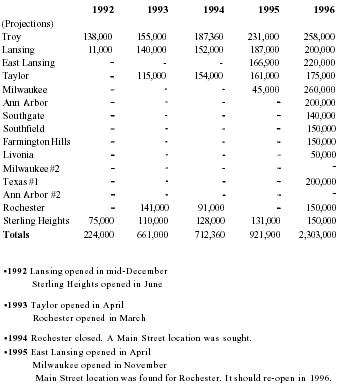
| 1992 | 1993 | 1994 | 1995 | 1996 | |
|
•1992
Lansing opened in mid-December
Sterling Heights opened in June |
|||||
|
•1993
Taylor opened in April
Rochester opened in March |
|||||
| •1994 Rochester closed. A Main Street location was sought. | |||||
|
•1995
East Lansing opened in April
Milwaukee opened in November Main Street location was found for Rochester. It should re-open in 1996. |
|||||
| (Projections) | |||||
| Troy | 138,000 | 155,000 | 187,360 | 231,000 | 258,000 |
| Lansing | 11,000 | 140,000 | 152,000 | 187,000 | 200,000 |
| East Lansing | – | – | – | 166,900 | 220,000 |
| Taylor | – | 115,000 | 154,000 | 161,000 | 175,000 |
| Milwaukee | – | – | – | 45,000 | 260,000 |
| Ann Arbor | – | – | – | – | 200,000 |
| Southgate | – | – | – | – | 140,000 |
| Southfield | – | – | – | – | 150,000 |
| Farmington Hills | – | – | – | – | 150,000 |
| Livonia | – | – | – | – | 50,000 |
| Milwaukee #2 | – | – | – | – | – |
| Texas #1 | – | – | – | – | 200,000 |
| Ann Arbor #2 | – | – | – | – | – |
| Rochester | – | 141,000 | 91,000 | – | 150,000 |
| Sterling Heights | 75,000 | 110,000 | 128,000 | 131,000 | 150,000 |
| Totals | 224,000 | 661,000 | 712,360 | 921,900 | 2,303,000 |
Food Truck Revenue
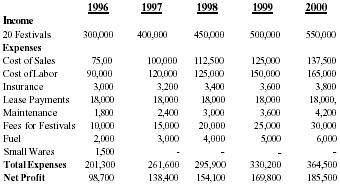
| 1996 | 1997 | 1998 | 1999 | 2000 | |
| Income | |||||
| 20 Festivals | 300,000 | 400,000 | 450,000 | 500,000 | 550,000 |
| Expenses | |||||
| Cost of Sales | 75,00 | 100,000 | 112,500 | 125,000 | 137,500 |
| Cost of Labor | 90,000 | 120,000 | 125,000 | 150,000 | 165,000 |
| Insurance | 3,000 | 3,200 | 3,400 | 3,600 | 3,800 |
| Lease Payments | 18,000 | 18,000 | 18,000 | 18,000 | 18,000 |
| Maintenance | 1,800 | 2,400 | 3,000 | 3,600 | 4,200 |
| Fees for Festivals | 10,000 | 15,000 | 20,000 | 25,000 | 30,000 |
| Fuel | 2,000 | 3,000 | 4,000 | 5,000 | 6,000 |
| Small Wares | 1,500 | – | – | – | – |
| Total Expenses | 201,300 | 261,600 | 295,900 | 330,200 | 364,500 |
| Net Profit | 98,700 | 138,400 | 154,100 | 169,800 | 185,500 |
Five Year Projected Income

| Royalties | 84,400 | 94,600 | 130,830 | 184,620 | 256,850 |
| New | – | 107,500 | 112,500 | 225,000 | 375,000 |
| Operations | 8,700 | 9,800 | 11,300 | 13,300 | 15,800 |
| Food Truck | 300,000 | 400,000 | 450,000 | 500,000 | 700,000 |
| New Stores | 90,000 | 250,000 | 300,000 | 500,000 | 700,000 |
| New Territories | 200,000 | 300,000 | 450,000 | 600,000 | 750,000 |
| Totals | 683,100 | 1,161,900 | 1,454,630 | 2,022,920 | 2,647,650 |
Profit and Loss Statement
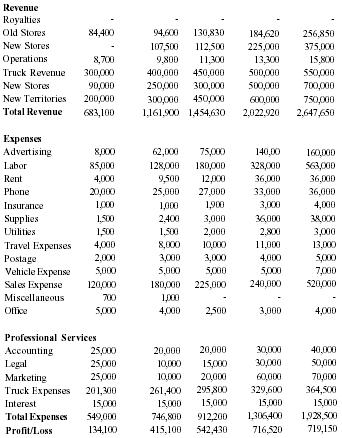
| Revenue | |||||
| Royalties | – | – | – | – | – |
| Old Stores | 84,400 | 94,600 | 130,830 | 184,620 | 256,850 |
| New Stores | – | 107,500 | 112,500 | 225,000 | 375,000 |
| Operations | 8,700 | 9,800 | 11,300 | 13,300 | 15,800 |
| Truck Revenue | 300,000 | 400,000 | 450,000 | 500,000 | 550,000 |
| New Stores | 90,000 | 250,000 | 300,000 | 500,000 | 700,000 |
| New Territories | 200,000 | 300,000 | 450,000 | 600,000 | 750,000 |
| Total Revenue | 683,100 | 1,161,900 | 1,454,630 | 2,022,920 | 2,647,650 |
| Expenses | |||||
| Advertising | 8,000 | 62,000 | 75,000 | 140,00 | 160,000 |
| Labor | 85,000 | 128,000 | 180,000 | 328,000 | 563,000 |
| Rent | 4,000 | 9,500 | 12,000 | 36,000 | 36,000 |
| Phone | 20,000 | 25,000 | 27,000 | 33,000 | 36,000 |
| Insurance | 1,000 | 1,000 | 1,900 | 3,000 | 4,000 |
| Supplies | 1,500 | 2,400 | 3,000 | 36,000 | 38,000 |
| Utilities | 1,500 | 1,500 | 2,000 | 2,800 | 3,000 |
| Travel Expenses | 4,000 | 8,000 | 10,000 | 11,000 | 13,000 |
| Postage | 2,000 | 3,000 | 3,000 | 4,000 | 5,000 |
| Vehicle Expense | 5,000 | 5,000 | 5,000 | 5,000 | 7,000 |
| Sales Expense | 120,000 | 180,000 | 225,000 | 240,000 | 520,000 |
| Miscellaneous | 700 | 1,000 | – | – | – |
| Office | 5,000 | 4,000 | 2,500 | 3,000 | 4,000 |
| Professional Services | |||||
| Accounting | 25,000 | 20,000 | 20,000 | 30,000 | 40,000 |
| Legal | 25,000 | 10,000 | 15,000 | 30,000 | 50,000 |
| Marketing | 25,000 | 10,000 | 20,000 | 60,000 | 70,000 |
| Truck Expenses | 201,300 | 261,400 | 295,800 | 329,600 | 364,500 |
| Interest | 15,000 | 15,000 | 15,000 | 15,000 | 15,000 |
| Total Expenses | 549,000 | 746,800 | 912,200 | 1,306,400 | 1,928,500 |
| Profit/Loss | 134,100 | 415,100 | 542,430 | 716,520 | 719,150 |
Exit Strategy
Equity and Debt Positions
In exchange for the $250,000 investment, Pasta Express is offering an equity position of $150,000 and a note for the remaining $100,000.
Terms
Pasta Express will pay 10% interest for three years on the note of $100,000. Pasta Express will give a 25% stock position in exchange for the remaining $150,000 investment. Pasta Express will buy out the 25% stock position at 2.5 times the initial investment, or the investor may choose to remain a stockholder in anticipation of a public stock offering. If a buyout is chosen, it will occur in late 1997 or 1998.
COMPANY DESCRIPTION
Mission Statement
Pasta Express provides the best-tasting and most nutritious meal in the fast food industry at a reasonable cost. Our customers may take this meal home with them or can enjoy it in an upbeat, comfortable atmosphere.
Services
Pasta Express is committed to the development of our restaurants through company-owned units, single-unit franchises, and Master Franchise territories. The concept is a turnkey system wherein the franchisor handles every step of the development process, beginning with the signing of the franchise or Master Franchise agreement, and proceeding to site selection, site design, layout, and blueprints, securing local government approvals and permits, store buildout, signage, ordering and installing food equipment, training, and grand opening. Pasta Express provides everything a franchise owner needs to develop and successfully operate a store. All the franchisee needs to supply is the funding.
Development
Founded in 1989, Pasta Express was designed to be franchised and developed into a national chain. The concept began with one company-owned location, and by 1995 the chain had expanded to six locations. All of those locations remain open and profitable. Four new locations will open in 1996.
Immediate development goals include increasing the number of local and national locations through franchise and Master Franchise sales, designing and building a company-owned freestanding prototype unit, increasing profitability at all locations, and further developing the corporate infrastructure to support national expansion.
Legal Name, Status, and Ownership
Pasta Express is incorporated under the laws of Michigan as an "S" Corporation. 90,000 shares of Pasta Express are outstanding and 53,500 have been issued. 36,000 shares are owned by Lynn Ott, the founder, president, and CEO. 17,5 00 shares are owned by David Huff. Shares have been selling for $20 per share. Your purchase will give you a 25% equity position, with 22,500 shares at a price of $6.70 per share.
INDUSTRY ANALYSIS
According to Maria Stevens, president of Stevens Consulting, the largest franchise consulting firm in the United States, "The pasta market … is very hot. There are a number of new franchisors, but nobody has established themselves as a runaway success." One of the greatest reasons that makes Pasta Express a great investment at this time is the fact that the pasta market is still in the development stage, providing a window of opportunity for us.
Fast Food Pasta—A Developing Industry
With the exception of Sbarro, which began in 1959 and started franchising in 1977, the fast food Italian pasta industry is brand new Sbarro is confined mainly to regional shopping malls. Among more traditional fast food locations, the first company to open a fast food Italian pasta store was Spaghetti Shoppe in 1985.
Open Competitive Market
In an emerging market, the goal of all industry competitors is to gain a foothold in the new market, create a brand identity within the market, and establish themselves as the clear leader. The players in this market are still in the "foothold" stage, with each trying to put as many stores in the best locations as quickly as possible all over the nation. Each of three industry leaders is developing their own brand identity within the market. However, no one has established itself as the clear industry leader. The opportunity to open the market nationwide is available to the company that is able to move most quickly into the major population and growth centers.
Long-Term Opportunities
Since the fast Italian market is still emerging, the long-term opportunities for Pasta Express are enormous. The national trend toward eating out has increased over the last five year. In 1993, the amount of money spent on restaurant food was equal to what was spent in homes for "homemade meals." 1993 was the first year that Americans spent as much on food outside the home as they did for meals inside the home. According to American Demographics Magazine, 1996 will be the first year that spending on restaurants and take-out food will exceed the nation's grocery bill. Since Americans are spending more on restaurant food than ever, these consumers are looking for more eating alternatives. The market demand for healthy, great-tasting menu items as an alternative to hamburgers, steaks, tacos, chicken, and pizza has never been greater. National chains such as Taco Bell and McDonald's have experimented with healthy menu items because they realize an enormous market is developing for healthy tasty food. Other chains like Boston Market are servicing an enormous market for homestyle meals in an upscale environment. Pasta Express is one of the best alternatives in the market to meet the demands of this new market segment.
Pasta Express—Poised to Dominate the Market
The restaurant industry in the United States has been characterized by rapid change. During the 1950s and '60s, dining out was a new experience to people who were just getting used to enjoying the post-war affluence. Local diners spread across the country and soon evolved into restaurant "chains" owned by local and regional corporations. Hamburger stands began to evolve into a new restaurant concept known as "fast food." In the '70s and '80s hamburger and pizza operations created a whole new market for menus alternatives such as chicken, fish, and tacos. Now the new restaurant trend is affordable fast food that has the home-cooked taste. The runaway success story of the early- to mid-1990s, Boston Chicken (Market) shows the untapped potential market. Rather than having to wait thirty minutes to an hour in a sit-down or casual dining restaurant, most consumers want a tasty fast food meal which families and single persons alike can enjoy. Pasta Express is on the cutting edge of this new restaurant trend. As the late 1990s empty into the next century, Pasta Express has poised itself to be the leader in the new concept.
COMPETITIVE ANALYSIS
There are five major competitors:
- Fazoli's
- Spaghetti Shoppe
- Little Caesar's Italian Kitchen
- Sbarro, the Italian Eatery
- Papa Romano's Pizza and Pasta
Fazoli's
Fazoli's currently operates 104 units. Eighty of these are company-owned and operated, and 24 are franchised units. The strength of the Fazoli's concept is its stress on opening freestanding units, which offers immediate visibility and credibility to the consumer. Despite their adequate funding, rapid growth, and free-standing store concept, they are vulnerable to the competition on three fronts. (1) Food Quality. The menu items and prices listed are nearly identical to ours, but the portions are smaller. (2) Start-Up Costs. The start-up costs for Fazoli's are projected between $400,000 and $795,000 per store, as opposed to $80,000 to $100,000 for Pasta Express. This enables us to qualify more potential franchisees, which enable faster development. (3) Name Recognition. One of the most important factors in establishing a company as a leader in any new industry is developing brand name and brand identity among potential customers. While it is not impossible to use an unfamiliar brand name, establishing the brand name and linking it to the product identity takes a significant amount of marketing funds. Companies that have been able to use a brand name to automatically link them to the target market (Coca-Cola, Boston Chicken, Subway, Burger King, Taco Bell, Pizza Hut, etc.) have a leg up on the competition in establishing brand identity. This is why Pasta Express has chosen its name. The name instantly informs the consumer that we are a fastfood Italian enterprise. Fazoli's does not have this advantage. Fazoli's is leading the fast food Italian trend, but has not established itself as the runaway leader.
Spaghetti Shoppe
With the exception of Sbarro, Spaghetti Shoppe has been in the fast food Italian franchising business the longest. Its menu is similar to Pasta Express, but the prices are a little higher. Spaghetti Shoppe, with both inline and free-standing stores, has 40 franchised units and one company store. The company has struggled recently, selling no franchises and closing one company store. This stagnation seems to be related to the high cost of opening a Spaghetti Shoppe. The projected opening costs are between $200,000 and $800,000. If a franchisee spent even the minimum $200,000 on an inline store, it would bedifficult to operated profitably for the first 3-5 years. Unless they can trim costs, strengthen their brand, and step up expansion, Spaghetti Shoppe will have difficulty becoming a market leader.
Little Caesar's Italian Kitchen
Although nationally known as a pizza chain, Little Caesar's has shifted its focus toward the pasta market in the last 12-16 months. This new concept is called Little Caesar's Italian Kitchen. The Little Caesar's Pizza chain currently operates 4,500 units in all 50 states and several foreign countries. Unlike Pasta Express, Little Caesar's does not offer the customer a made-to-order option for pasta; the pasta is pre-cooked, pre-sauced, and sitting under a food warmer waiting for the customer to order. The menu offers only limited kinds of noodles and sauces, and very few of the locations offer dine-in options. The strategy and placement of the Italian Kitchen within Little Caesars's Enterprises is extremely limited at this point. With the Little Caesar's Pizza chain adding delivery (in an attempt to cannibalize the market share of Domino's Pizza) and adding new menu items (i.e., stuffed crust pizza) to compete with Pizza Hut, marketing and strategy has focused on strengthening the position of Little Caesar's Pizza in the pizza market. This renewed focus has come at the expense of research, development, and marketing of Little Caesar's newest concepts, especially Italian Kitchen. Although the pizza market has been flooded for years, competitors continue to pour into this lucrative segment. Unfortunately, this market is beginning to mature and all parties are positioning themselves to compete with each other for a stagnant number of consumers. This does not bode well for the Italian Kitchen concept, which still faces major developmental and marketing challenges and needs capital to strengthen their competitive position. Little Caesar's Italian Kitchen has two enormous strengths but, as with many mature companies, its greatest strengths can also be their major weaknesses: (1) Brand Recognition. Millions of consumers already know and love Little Caesar's Pizza Pizza. A decision to offer pasta in every location will make Little Caesar's a major competitive force. However, having to live down a reputation as a "pizza" restaurant is a major competitive disadvantage for the Little Caesar's Italian Kitchen concept. The brand identification with the pizza is so strong that an enormous amount of marketing would be needed to make pasta a major contributor to their sales revenue. At this point in development, the revenue generated from pasta is so small that the franchisees are less likely to invest in food equipment, remodeling costs, marketing, and food and labor costs to change to the Italian Kitchen. Focusing on the pizza customer is the option franchisees will most likely choose. (2) Financial Resources. Given their success in the pizza and franchising business, Little Caesar's Enterprises has an enormous resource pool which could be dedicated to becoming a major player in the fast food pasta industry. However, given the enormous amount of capital already spent to establish Little Caesar's as a major pizza brand name and the intense competition Little Caesar's faces in the pizza market with Pizza Hut Delivery and Domino's it seems unlikely that Little Caesar's Italian Kitchen will ever be a major factor in the pasta market.
Sbarro, the Italian Eatery
Sbarro, the grandfather of the fast Italian pasta business, has been in business since 1959 and began franchising in 1977. It has 578 company owned units and 146 franchised units in the United States alone. In Canada and other countries, Sbarro maintains 36 franchised units. Although it bills itself as "The Italian Eatery" and is well-capitalized, Sbarro is not in the same class as Pasta Express. It offers mainly pizza and Italian pies, along with baked ziti and garlic bread. Such items as lasagna, spaghetti, mostaccoli, linguini, fettucini, and marinara and alfredo sauces are not often on the menu. In addition, the prices are often significantly higher than ours and the market is much different, since Sbarro has dedicated itself almost exclusively to food courts in shopping malls. Finding Sbarro in a free-standing unit or an inline store is very rare, and any such units do not carry the staple menu items of a Pasta Express. If Sbarro attempted to establish itself as our competitor, it would have the advantages of capitalization and brand recognition. In addition, high start-up costs ($179,000 to $723,000) and the highest franchise fees ($35,000 and 5% royalties) make Sbarro an expensive option for would-be franchisees. Someone interested in competing with Pasta Express is more likely to choose Fazoli's or Spaghetti Shoppe. Thus Pasta Express regards Sbarro as only a peripheral competitor at this time.
Papa Romano's
With 66 franchises and five company-owned units, Papa Romano's Pizza and Pasta has established itself as a developing player in the pizza market. Although it has strong brand recognition in the Detroit, Michigan area, its development outside Michigan is still in its infancy. While a limited amount of pasta products are available, Papa Romano's overwhelming source of revenue is pizza. All of the marketing currently conducted is targeted toward the pizza consumer. Their commitment to pasta appears to be only as a menu alternative. Because of their commitment to the pizza enterprise, they face an even greater challenge than Little Caesar's — they have fewer financial resources and have not established themselves as a major player nationally. If they were to switch focus mid-stream to compete in the fast Italian market, they would face a number of developmental hurdles which Pasta Express, Fazoli's, and Spaghetti Shoppe have already conquered. Additionally, they would have to scrap all their advertising and start fresh in an attempt to develop a brand identity in the fast Italian pasta market. This makes Papa Romano's an unlikely competitor.
Several other major chains, including Olive Garden and Salvatore Scaloppini, sellpasta, but they are not directly competitive since the venues and pricing differ dramatically from Pasta Express. These restaurants were designed for sit-down consumption of pasta in a more formal atmosphere. They are not easily accommodating to carry-out customers, nor can they handle the volume that a Pasta Express handles. In addition, the prices are often twice what a customer at Pasta Express would pay for a comparable meal.
Pasta Express differs from other quick serve operations in three ways. Some of our competitors may combine one or two of the following ideas, but none have all three in their favor.
Pasta Express offers more delicious menu options than any other quick serve restaurant:
- Pasta noodle: spaghetti, fettucini, linguini, mostaccioli, lasagna and many more
- Gourmet sauces: meat sauce, meat sauce with fresh mushrooms, alfredo sauce, marinara sauce, and pesto sauce
- Chicken dishes: chicken cacciatore, chicken caesar salad, chicken alfredo, chicken broccoli alfredo, chicken parmesan, chicken parmesan sandwich, and chicken primavera
- Fresh salads: garden salad, tossed salad, pasta salad, greek salad, antipasto salad, and caesar salad
- Hot sandwiches: meatball, Italian, ham & cheese, and vegetarian
- Soup: vegetable, minestrone, and chicken noodle
- Cheesecake
Pasta Express is the only quick serve restaurant offering healthy menu alternatives.
In addition to providing a low-fat marinara sauce and salads, Pasta Express has retained the services of a nutritionist to aid us in the development of a healthy alternatives menu for all locations.
Pasta Express is one of the few quick serve restaurants to offer a party menu.
We provide gourmet food at reasonable prices. Pasta Express is by far the most cost available of all the major competitors, making the pool of potential franchisees and area developers much larger that for the other competitors.
HISTORY
Pasta Express was created to fill an obvious opening in the fast food market. William Grumman, the founder, was operating a very successful local pizzeria. Since he was not satisfied with a local-only concept, he had only one option: find a market that is just opening and prepare to capitalize on it. Although hamburgers, chicken, pizza, and Mexican food markets were already saturated with intense competition, Mr. Grumman's vision was to satisfy a desire for high quality Italian food. Some pizzerias were offering pasta as a menu alternative, the quality was poorer and the selection limited to spaghetti or lasagna. The only other alternative was to eat in a casual or fine dining restaurant where pasta meals were not designed for people on the move and the average cost was $10-$12.
The popularity of pasta increased at a tremendous rate in the mid-1980s and the USDA included pasta as one of the seven food groups in the Food Pyramid. After realizing this, Mr. Grumman formed the vision that governs Pasta Express to this day. He wanted to design a company similar to Pizza Hut, Domino's and Little Caesar's. In 1987, Pasta Express was launched. The first three years were spent developing the concept in one company owned store, preparing the operations manual and completing the legal requirements for franchising. In 1991, he sold one franchised unit. By 1994, 8 franchises were sold. In 1995, two stores were sold locally and the first two Master Franchise territories were sold in Milwaukee, Wisconsin and Houston, Texas. The concept of the third generation store was also introduced in 1995.
CURRENT STATUS
As of January 1996, eight stores are operating and three more will be operational by March. Four other stores are in development and scheduled to open this year. In addition, several franchise and Master Franchise territories are in negotiations. We project selling at least three Master Franchise territories this year and opening at least ten individual units. With the proper financing, we will begin development of our first free-standing store, a company-owned unit.
MANAGEMENT PROFILE
Lynn Ott
- President and Secretary/Treasurer of Pasta Express since it incorporation
- Sixteen years in the food industry
- Expert in restaurant management, business administration, real estate, and marketing
- Owned a succesful sit-down pizza and pasta restaurant
- Ten years of experience with the Pizza Hut chain of restaurants, attaining the role of General Manager, Assistant Area Manager, and Turn Around Specialist
- B.A. in Accounting and a brokers license in real estate
David Huff
- Mr. Huff is the Vice President and Director of Pasta Express
- Works closely with the franchise attorney to ensure that the Uniform Franchise Offering Circular (UFOC) is current
- Responsible for organizing and implementing the food truck program
- Vice President and CFO of a successful retail sportswear company
- Responsible for all financial consideration of day-to-day operations as well as personnel manager for all employees. He has developed and coordinated all accounting procedures for the management of multiple locations
- Has several years in the food service industry where he was responsible for food management, ordering and inventory control, and implementing new food products and promotions
- Expert in retail sales, multiple location mangement, and finance
Samuel Smith
- Mr. Smith is the General Manager.
- Experience in management and administration
- Head of research and development, marketing strategy, operational improvement, and franchise expansion
- Coordinates franchise support efforts between the stores
- Responsible for qualifying and developing franchise candidates
- Regarded nationwide as an expert in the field of franchise sales
- Twenty years of experience in the franchise industry
- Also owns his own franchise consulting firm which has been profiled in The Detroit News and The Detroit Free Press, Crain's Detroit Business, and Franchise Buyer
- Has been interviewed on national TV and radio and is a major source in the franchise industry for all media outlets, including The Wall Street Journal
- Advisory board member and quarterly article writer for Franchise Handbook
Jodi Jones
- Marketing Director
- Produces all electronic and print media material used for advertising and store promotion
- Manages the advertising message and ensures that Pasta Express is successful in reaching its target market
- Former Broadcast Supervisor for Campbell-Ewald Company, where she handled advertising for Magnavox, Goodyear, A.C. Delco, Delco Electronics, National Car Rental, GMAC, and others
- Twenty years in the advertising business
- Owns and operates her own advertising firm
Kathleen Olivera
- Chief Financial Officer
- Handles the financial reports
- Accredited Business Accountant
- Owns and operates her own accounting and tax prepartion firm, Olivera and Associates
- Enrolled to practice before the Internal Revenue Service
- Member of the Independent Accountants Association of Michigan
Cameron Powers
- Operations Manager and Training Manager
- Fourteen years of experience in the restaurant business
- Expert in the operational areas
- Authored major sections of the Pasta Express Operations Manual
William Stewart
- Buildout Manager
- Proposed manager of food truck operations
- Six years of experience in food truck management for Ernesto's Pizza and Pasta
- Twenty years of restaurant management experience with Pizza Hut and Big Boy Restaurants
COMPILED FINANCIAL STATEMENTS
Statement of Income and Retained Earnings
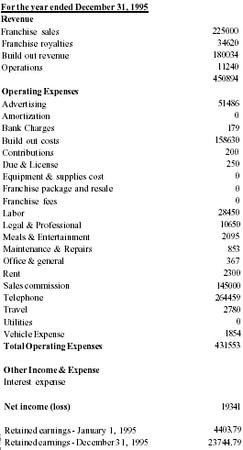
| For the year ended December 31, 1995 | |
| Revenue | |
| Franchise sales | 225000 |
| Franchise royalties | 34620 |
| Build out revenue | 180034 |
| Operations | 11240 |
| 450894 | |
| Operating Expenses | |
| Advertising | 51486 |
| Amortization | 0 |
| Bank Charges | 179 |
| Build out costs | 158630 |
| Contributions | 200 |
| Due & License | 250 |
| Equipment & supplies cost | 0 |
| Franchise package and resale | 0 |
| Franchise fees | 0 |
| Labor | 28450 |
| Legal & Professional | 10650 |
| Meals & Entertainment | 2095 |
| Maintenance & Repairs | 853 |
| Office & general | 367 |
| Rent | 2300 |
| Sales commission | 145000 |
| Telephone | 264459 |
| Travel | 2780 |
| Utilities | 0 |
| Vehicle Expense | 1854 |
| Total Operating Expenses | 431553 |
| Other Income & Expense | |
| Interest expense | |
| Net income (loss) | 19341 |
| Retained earnings - January 1, 1995 | 4403.79 |
| Retained earnings - December 31, 1995 | 23744.79 |
Statement of Assets and Liabilities—Accrual Basis
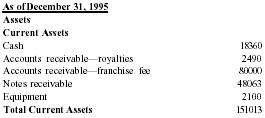
| As of December 31, 1995 | ||
| Assets | ||
| Current Assets | ||
| Cash | 18360 | |
| Accounts receivable—royalties | 2490 | |
| Accounts receivable—franchise fee | 80000 | |
| Notes receivable | 48063 | |
| Equipment | 2100 | |
| Total Current Assets | 151013 | |
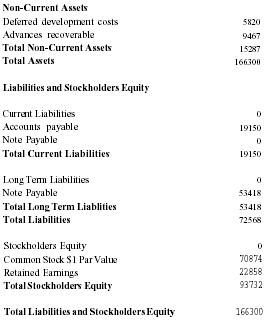
| Non-Current Assets | |
| Deferred development costs | 5820 |
| Advances recoverable | 9467 |
| Total Non-Current Assets | 15287 |
| Total Assets | 166300 |
| Liabilities and Stockholders Equity | |
| Current Liabilities | 0 |
| Accounts payable | 19150 |
| Note Payable | 0 |
| Total Current Liabilities | 19150 |
| Long Term Liabilities | 0 |
| Note Payable | 53418 |
| Total Long Term Liablities | 53418 |
| Total Liabilities | 72568 |
| Stockholders Equity | 0 |
| Common Stock $1 Par Value | 70874 |
| Retained Earnings | 22858 |
| Total Stockholders Equity | 93732 |
| Total Liabilities and Stockholders Equity | 166300 |
Comment about this article, ask questions, or add new information about this topic: